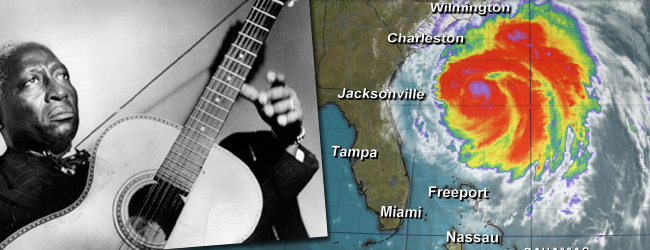
Today brings a very timely new entry in American Blues Scene’s exclusive “Brief History of a Song” series. With Hurricane Irene bearing down on the east coast of the United States, the classic Leadbelly folk tune has experienced a recent resurgence of popularity.
It seems, for the past three days, the phrase “Good Night Irene” has been scrawled across the internet and the east coast of the United States, as residents waited with great angst for Hurricane Irene to make landfall, on the heels of an earthquake that shook many east coast resident’s confidence in mother nature. The phrase “Good Night, Irene”, which has momentarily surged back to the popular eye, is actually an old pop culture reference to a blues song.
Huddie ‘Lead Belly’ Ledbetter was one of the most influential musicians of the 20th century. Passing away in 1949, he was a towering icon of not only the blues, but not long after his death, would become a father of the folk music explosion. Among those who have avidly claimed Leadbelly as a major influence on their music were Bob Dylan, Creedence Clearwater Revival, The Allman Brothers, and even Kurt Cobain. He was the essence of what an early blues man often endured. Sent to prison three times, the first time allegedly escaping from a chain gang and another time after killing a man, it was in a Texas prison that his music prowess was discovered by none other than legendary folk musicologist John Lomax. In 1933, Lomax made the first-ever recorded version of “Midnight Special” and “Good night, Irene”, the song for which Leadbelly was most well known. Like so many folks songs, the original origins of the song have been lost the past. Leadbelly never claimed full authorship of the song, having mentioned that he learned it from a relative. Regardless of how much of the original song was borrowed, it was greatly modified by Huddy, and since it’s recording, has always been attributed to the singer. “Goodnight, Irene” was essentially a song of heartache, which may be fitting in it’s current setting as a ominous reference to the hurricane Irene. The lyrics discuss Irene breaking the narrator’s heart by staying out all night gambling. The narrator toys with the idea of suicide to ease his heavy heart– overdosing on morphine or jumping into a river.
Just 6 months after Lead Belly passed away, The Weavers’ cover of “Goodnight, Irene” shot up the Billboard Best Seller chart, staying for 6 months and peaking at #1. The song had previously been covered by other artists such as Mississippi John Hurt, though the popularity of The Weavers’ version, along with a cover by Frank Sinatra at about the same time, propelled the song to new heights. Since 1950, the song has been covered regularly, with Johnny Cash, Jimi Hendrix, The Grateful Dead, Dr. John and, unsurprisingly, Tom Waits, all making popular covers of the song. Perhaps the ease of the song, both in chord structure and in listening, has helped keep the song on collective minds over 60 years after the death of it’s creator. “Goodnight, Irene” is a waltz, and written in a simple 3/4 time.
It is unfortunate that the current surge of recognizance for, and references to, the Leadbelly song must come on the cusps of a hurricane that shares it’s name. Though the east coast is no stranger to hurricanes, preparing for the worst never becomes an easy task. As the hurricane embarks on it’s widely destructive path along the east coast, please keep those who are currently being displaced and endangered in mind.



4 Comments
This is a great article with a nice slice of blues history for all of us to take in. I’ll look for your page on ‘bluescentric’. Thank you for your words of concern. Safe travels everyone.
Thanks, Bluebird!! Keep rockin’!